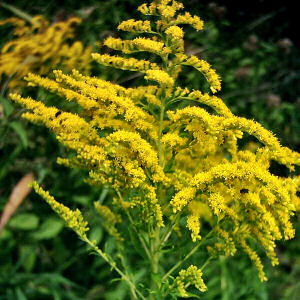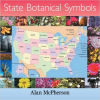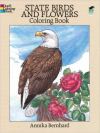
HOME
INTRO
SYMBOLS
ALMANAC
ECONOMY
GEOGRAPHY
STATE MAPS
PEOPLE
FORUM
NEWS
COOL SCHOOLS
STATE QUIZ
STATE LINKS
BOOK STORE
MARKETPLACE
GUESTBOOK
CONTACT US


You may double left-click on a word on this page to retrieve its definition. Tweet Follow
South Carolina State Wildflower

South Carolina State Wildflower: Goldenrod
ALLPOSTERSURL
After years of effort, the work of Nancy Odom, State Wildflower Chairman for the Garden Club of South Carolina paid off when, on May 14, 2003, Governor Mark Sanford signed legislation making goldenrod (Solidago altissima), the species commonly called tall goldenrod, the official wildflower of South Carolina.
Spearheading a statewide effort, Odom had contacted garden clubs throughout the state with her idea of a state wildflower to spark interest in native plantings. To educate the public, garden clubs were asked to present programs on wildflowers and then nominate a preferred flower for promotion as the state's official wildflower.
Queen Anne's lace was the big winner with the clubs, but it was determined that this plant was not native to South Carolina. The runner-up, goldenrod moved to the forefront.
Bills introduced in the 114th Session of the General Assembly (2001-2002) failed to gain traction. Efforts continued however.
House Bill No. 3233 of the 115th Session of the South Carolina General Assembly met a different fate. Introduced for the first time in the House on January 14, 2003 by Representative Scott F. Talley of Spartanburg, the offering met with a more receptive audience. House Bill No. 3233 was approved and on its way to the Senate before the end of the month.
The Senate received House Bill No. 3233 and had approved the action by April 23rd.
The following text represents House Bill No. 3233 as approved by the Senate:
AS PASSED BY THE SENATE
April 23, 2003
H. 3233H. 3233
A BILLIntroduced by Reps. Talley, Altman, Walker and Clemmons
TO AMEND THE CODE OF LAWS OF SOUTH CAROLINA, 1976, BY ADDING SECTION 1 1 704 SO AS TO DESIGNATE GOLDENROD THE OFFICIAL STATE WILDFLOWER.
S. Printed 4/23/03--S.
Read the first time January 30, 2003.Amend Title To Conform
Whereas, the Goldenrod is a strong, fibrous perennial found in meadows, fields, and along roadsides which grows in full sun to part shade needing only average moisture, making it a very tough and durable plant; and
Whereas, Goldenrod, contrary to popular belief, does not cause allergies to flare as the Goldenrod pollen is too heavy to blow in the wind; and
Whereas, the bright yellow flowers are very long-lasting and the bloom time is very long with the plant forming a dense clump that can be divided, and can reseed itself, allowing the plant to multiply every year; and
Whereas, Goldenrod, when cut back, produces more blooms than usual; and
Whereas, the ubiquitous Goldenrod, so familiar to South Carolinians in every generation, is an ideal candidate for the exalted position of “official state wildflower”. Now, therefore,
Be it enacted by the General Assembly of the State of South Carolina:
SECTION 1. Article 9, Chapter 1, Title 1 of the 1976 Code is amended by adding:
"Section 1-1-704. Goldenrod (Solidago altissima) is the official state wildflower."
SECTION 2. This act takes effect upon approval by the Governor.
---XX---
On May 14, 2003, the goldenrod (Solidago altissima) was adopted as the official state wildflower of South Carolina.
South Carolina now has two official flowers. In 1924, the yellow jessamine was selected by the General Assembly as the official state flower of the state.
Two other states have adopted a variety of goldenrod as an official flower:
- Nebraska as their official floral emblem in 1895.
- Kentucky as their official state flower in 1926.
South Carolina Law
The following information was excerpted from the South Carolina Code of Laws, Title 1, Chapter 1, Article 9, Section 1-1-704.
Title 1 - Administration of the Government
CHAPTER 1. GENERAL PROVISIONS
ARTICLE 9. STATE EMBLEMS, PLEDGE TO STATE FLAG, OFFICIAL OBSERVANCES
SECTION 1-1-704.
SECTION 1-1-704. Official State wildflower.
Goldenrod (Solidago altissima) is the official state wildflower.
Sources...
"South Carolina Now Has a State Wildflower: Goldenrod." South Carolina Native Plant Society. State of South Carolina Native Plant Society, n.d. Web. 9 Sept. 2009.
"H*3233 (Rat #0077, Act #0031 of 2003)." South Carolina Legislature. South Carolina Legislative Services Agency, 11 June 2003. Web. 8 Aug. 2016.
"South Carolina Code of Laws." South Carolina Legislature. South Carolina Legislative Services Agency, 17 May 2016. Web. 8 Aug. 2016.
Shearer, Benjamin F. and Barbara S. State Names, Seals, Flags and Symbols: A Historical Guide Third Edition, Revised and Expanded. Westport, Conn: Greenwood Press, 3 Sub edition, 2001.
Additional Information

South Carolina State Wildflower: Goldenrod
ALLPOSTERSURL
Tall Goldenrod – South Carolina State Wildflower: South Carolina Information Highway.
Lady Bird Johnson Wildflower Center: Website for the Lady Bird Johnson Wildflower Center in Austin, Texas.
Plant Profile for Solidago altissima L.: USDA, NRCS. 2004. The PLANTS Database, Version 3.5 (http://plants.usda.gov). National Plant Data Center, Baton Rouge, LA 70874-4490 USA.
South Carolina Native Plant Society: Web site of the South Carolina Native Plant Society.
Wildflower Alliance of South Carolina: PO Box 12181, Columbia, SC 29211 Tel: 803-799-6889
Roadside Use of Native Plants: US Department of Transportation, Federal Highway Administration.
Wildflower Gardening in South Carolina :
South Carolina Department of Transportation an Clemson University Extension: EC 680, Revised May 2002.
:
South Carolina Department of Transportation an Clemson University Extension: EC 680, Revised May 2002.
State wildflowers: Complete list of official state wildflowers from NETSTATE.COM
More symbols & emblems: Complete list of official South Carolina state symbols from NETSTATE.COM.

A Guide to the
Wildflowers of South Carolina
Richard Dwight Porcher
Douglas Alan Rayner
A Guide to the Wildflowers of South Carolina, by Richard Dwight Porcher and Douglas Alan Rayner. 544 pages. Publisher: University of South Carolina Press (February 2002)
Although relatively small in size, the Palmetto State hosts a remarkable variety of wildflower species, from the trillium and bloodroot that brighten its forests to heliotrope and common toadflax that dot the state's roadsides and fields. With color photographs (all by Richard D. Porcher) and extensive descriptions of more than 680 species, A Guide to the Wildflowers of South Carolina offers a complete and indispensable reference for finding and appreciating these natural treasures. Species are grouped by habitat. species according to habitat. For each species identified, the authors include interesting facts - many not widely known or readily available - about rarity, suitability for garden cultivation, and origin of common and scientific names.

Wild Orchids of
South Carolina
James Alexander Fowler
Wild Orchids of South Carolina: A Popular Natural History, by James Alexander Fowler. 99 pages. Publisher: University of South Carolina Press (February 9, 2005)
Orchids in any setting make for a beautiful sight, but native orchids growing in their natural habitats offer an especially rewarding view for plant enthusiasts, naturalists, and nature lovers of all ages. South Carolina hosts a rich potpourri of these enormously popular wildflowers, thanks in large part to its unique position as the lower boundary of more northerly species and upper boundary of species found in Florida and the gulf states. In Wild Orchids of South Carolina, James Alexander Fowler captures with spectacular photography and encyclopedic knowledge the full glory of the state's native orchid population. From the bogs and bays of the coastal plain to the mountain woodlands, Fowler catalogs rare and widely distributed species, offering a wealth of information for identifying these prized plants.
In addition to providing photographs of each species, Fowler includes common and scientific names, flower descriptions, bloom times, ranges, habitats, pollinators, and refreshingly candid personal observations about the orchids as he encountered them in the wild. He details his experiences of coming upon a show-stopping colony of large yellow lady's slipper orchids (Cypripedium parviflorum var. pubescens) and of locating the rare monkey-face orchid (Platanthera integrilabia).
Paul Martin Brown, a nationally renowned botanist and wild-orchid specialist, provides an introduction to the volume. He explains South Carolina's significance in the larger context of North American orchid habitats and prepares the reader for the striking display of beauty and information assembled in this volume.

State Botanical Symbols
Alan McPherson
State Botanical Symbols, by Alan McPherson. 132 pages. AuthorHouse (June 10, 2013)
Alan McPherson is a naturalist who resides in northern Indiana and enjoys traveling and learning about the botanical resources our vast country.
In this reference book over 200 state botanical symbols are presented with informative text that highlights their adoptive legislation, botanical and social history. From the white pine of Maine's northeastern forests, westward to the yellow hibiscus of Hawaii's Polynesian islands, our state's official botanical symbols are as uniquely diverse as the terrain and character of the 50 states themselves.

State Birds and Flowers
Coloring Book

U.S. State Flowers
in Counted Cross Stitch
Gerda Bengtsson
State Birds and Flowers Coloring Book
by Annika Bernhard
51 accurately detailed, copyright-free renderings include national bird (eagle) and flower (rose) plus 50 state birds and flowers.
U. S. State Flowers in Cross Stitch
by Gerda Bengtsson - Botanically correct cross stitch designs of state flowers of the 50 States.
Quilting Flowers of the States
by Sue Harvey - A lovely 12-inch flower block for each of the 50 states. Techniques used are piecing, appliqué, paper-piecing and three-dimensional techniques.
Plants, Seeds & Flowers:
Bulbs, seeds, plants, fertilizer, plant containers, garden tools and more.

